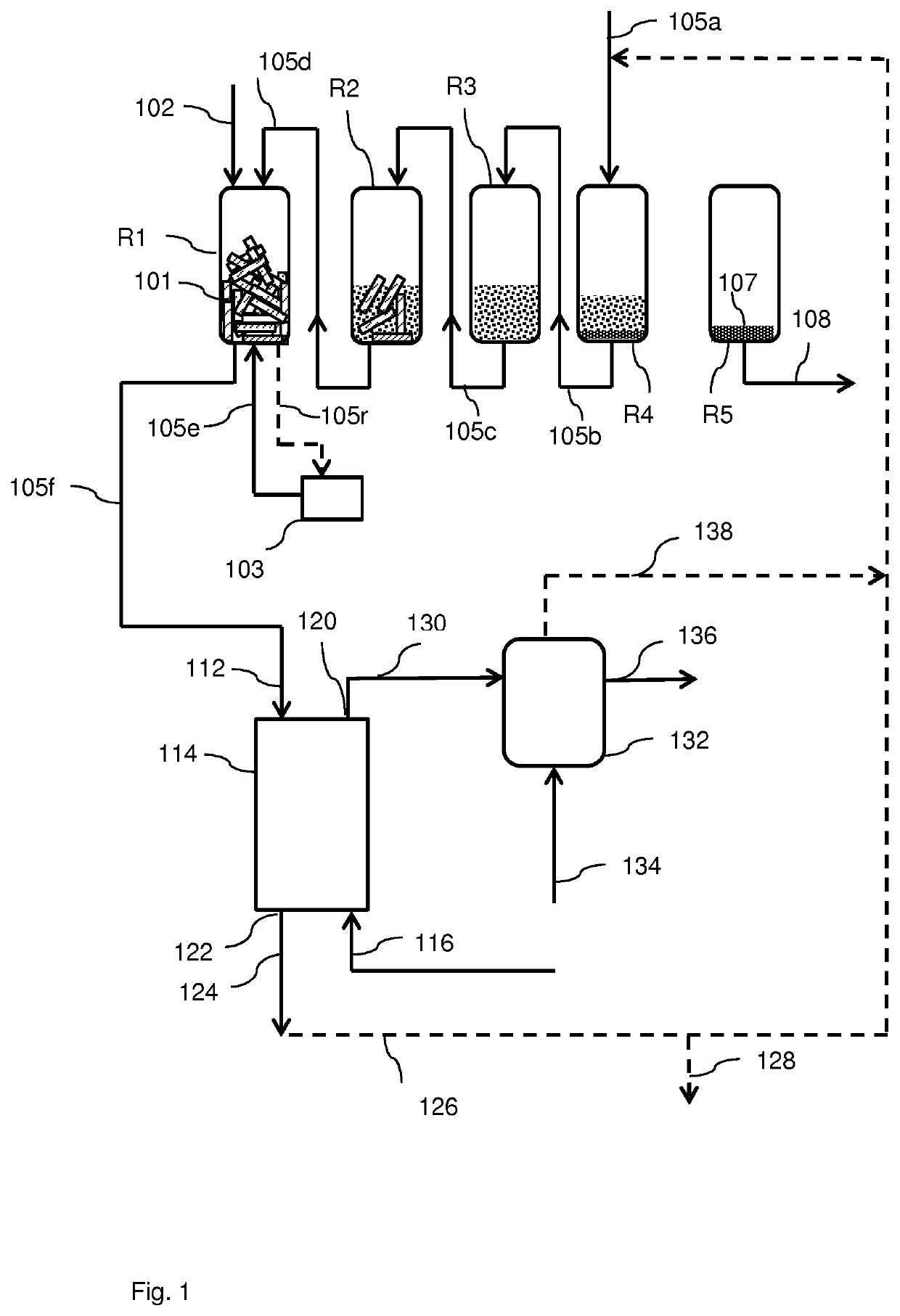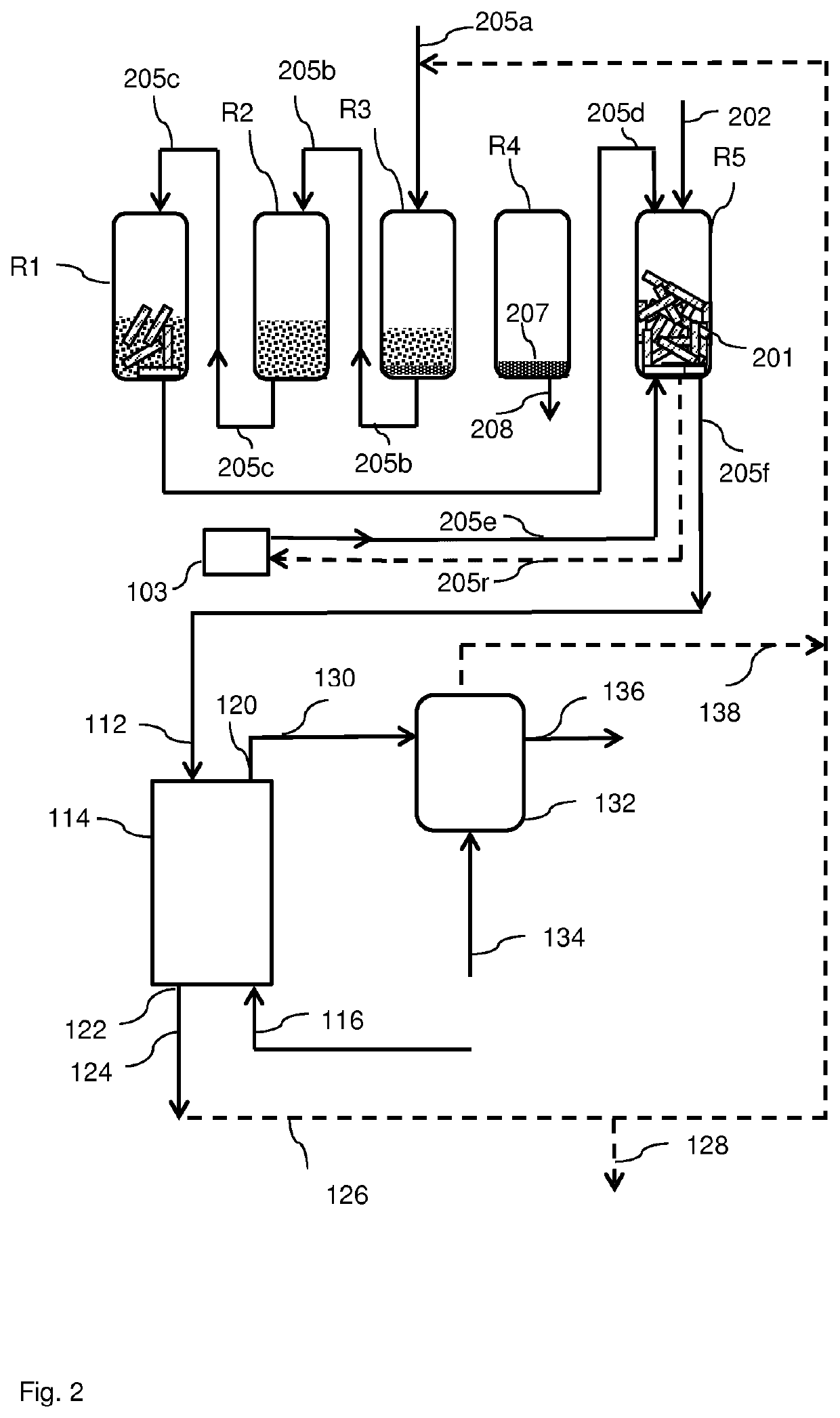A process for the conversion of a solid lignocellulosic material
- Summary
- Abstract
- Description
- Claims
- Application Information
AI Technical Summary
Benefits of technology
Problems solved by technology
Method used
Image
Examples
example 1
[0186]An amount of pine wood was hydrolyzed by treatment with an aqueous solution containing about 42 wt % hydrochloric acid (HCl) at room temperature (about 20° C.). After treatment the liquid was separated from the remaining residue, resulting in an hydrochloric acid-containing, aqueous hydrolysate solution, hereafter called hydrolysate product.
[0187]The hydrolysate product contained components as illustrated in Table 1.
TABLE 1Composition of the hydrolysate product.ComponentContent (wt %)Cellobiose0.098Galacturonic acid0.038Glucose5.76Mannose0.50Arabinose0.019Glucuronic acid0.10
example 2
Conversion of the Hydrolysate Product
[0188]The hydrolysate product obtained in example 1 was used as the substrate, without purification, for the conversion to 5-chloromethyl furfural (CMF). Both glucose and mannose were considered to be substrates for 5-chloromethyl formation. Experiments were run in blocks of 12 parallel 7.7 mL stainless steel batch reactors with Teflon liners using magnetic stirring at 1200 rpm. An amount of the hydrolysate substrate as listed in Table 2 was weighed in the reactor after which extraction solvent was added. The extraction solvent was toluene for all experiments. Just prior to closing the reactors an amount of aqueous solution containing about 37 wt % hydrochloric acid (HCl) was added, subsequently followed by immediate insertion into the heating block, where the reactor contents were heated to a temperature (T) as listed in Table 2. After the reaction time (t) as indicated in Table 2, the blocks were removed and cooled in an ice bath. Subsequently ...
example 4
Conversion of 5-Chloromethylfurfural
[0190]An amount of 5-Chloromethylfurfural (CMF) as listed in Table 3 was weighed in 1.8 mL HPLC vials and dissolved in an amount of dichloromethane (DCM) solvent as listed in Table 3. To such solution of CMF in dichloromethane solvent, methanol (MeOH) was added in an amount as listed in Table 3. Directly after addition of the methanol to the reaction mixture, the vials were heated to a temperature (T) as listed in Table 3 to start the reaction. After a reaction time (t) as listed in Table 3, the vials were directly cooled in an ice bath, followed by work-up for analysis (gas chromatography and ultra performance liquid chromatography). Table 4 provides an overview of the conversion of 5-Chloromethylfurfural (CMF) and the yields and selectivity towards 5-(methoxymethyl)furfural (MMF).
TABLE 4AmountYieldConversionSelectivityCMFTtDCMMeOHMMFCMFMMF(mg)(° C.)(h)(μL)(μL)(mol %)(mol %)(mol %)10.150435015084.697.586.810.950425025079.798.680.811.550225025078....
PUM
| Property | Measurement | Unit |
|---|---|---|
| Temperature | aaaaa | aaaaa |
| Temperature | aaaaa | aaaaa |
| Temperature | aaaaa | aaaaa |
Abstract
Description
Claims
Application Information
 Login to View More
Login to View More - R&D
- Intellectual Property
- Life Sciences
- Materials
- Tech Scout
- Unparalleled Data Quality
- Higher Quality Content
- 60% Fewer Hallucinations
Browse by: Latest US Patents, China's latest patents, Technical Efficacy Thesaurus, Application Domain, Technology Topic, Popular Technical Reports.
© 2025 PatSnap. All rights reserved.Legal|Privacy policy|Modern Slavery Act Transparency Statement|Sitemap|About US| Contact US: help@patsnap.com


